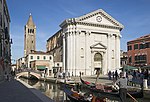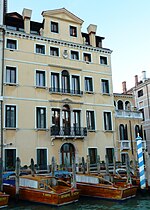Ca' Rezzonico
Art museums and galleries in VeniceArt museums established in 1936Baldassare Longhena buildingsBaroque architecture in VeniceHouses completed in 1758 ... and 2 more
Palaces in Sestiere DorsoduroPalaces on the Grand Canal (Venice)

Ca' Rezzonico (Italian pronunciation: [ˈka rretˈtsɔːniko]) is a palazzo and art museum on the Grand Canal in the Dorsoduro sestiere of Venice, Italy. It is a particularly notable example of the 18th century Venetian baroque and rococo architecture and interior decoration, and displays paintings by the leading Venetian painters of the period, including Francesco Guardi and Giambattista Tiepolo. It is a public museum dedicated to 18th-century Venice (Museo del Settecento Veneziano) and one of the 11 venues managed by the Fondazione Musei Civici di Venezia.
Excerpt from the Wikipedia article Ca' Rezzonico (License: CC BY-SA 3.0, Authors, Images).Ca' Rezzonico
Fondamenta Rezzonico, Mestre Venezia-Murano-Burano
Geographical coordinates (GPS) Address Website External links Nearby Places Show on map
Geographical coordinates (GPS)
| Latitude | Longitude |
|---|---|
| N 45.433425 ° | E 12.326816666667 ° |
Address
Museo Ca' Rezzonico
Fondamenta Rezzonico 3136
30170 Mestre, Venezia-Murano-Burano
Veneto, Italy
Open on Google Maps










